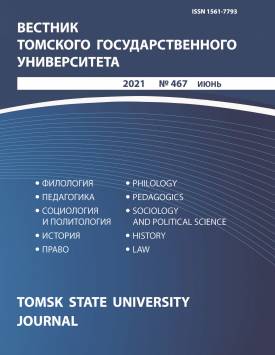Legal Framework for Migration Policy in Russia and the European Union
In this study, the authors address the problem of the role of legal regulation of migration processes in the framework of strategic cooperation between the Russian Federation and the European Union. The authors focus the content of migration policy, the system of sources of its legal regulation, and the specifics of its practical implementation in Russia at the present stage of development. The aim of this article is to identify the main directions and legal regulators of state migration policy in the framework of cooperation between Russia and the European Union. The relationship between the implemented migration policy and the restrictions imposed by the states in this area is determined. The study is based on the theoretical material of the works of Russian (I.P. Doroshina, V.I. Evtushenko, V.I. Zabavka, M.M. Pukhova, I.G. Khodzhaeva, and others) and foreign (M. Malfe, A. Mandralis, F. Eran, and others) researchers. International agreements, Russian federal sources of law (federal legislation and acts of individual authorities), reports of Russian and foreign organizations were also used. The methodological basis of the research was the dialectical, comparative legal, and formal legal methods. In particular, the use of the dialectical method contributed to the study of the legislation regulating the migration policy in Russia in its formation and development. The use of comparative legal and formal legal methods helped to identify trends in the establishment and development of partnerships in the field of migration policy in Russia and the European Union, as well as the prospects for the use of certain legal instruments in Russia. As a result, the authors came to the conclusion that today both Russia and the European Union are faced with various socio-economic problems and threats to national security; therefore, they implement different models of migration policy. The analysis of internal documents of Russia and the European Union, as well as joint treaties and agreements, made it possible to draw conclusions and identify problems related to the sphere of migration policy. For the most part, the countries’ interaction in the field of migration is governed by framework agreements or recommendatory documents. Undoubtedly, such regulation is convenient because such documents are easy to change depending on the political and economic situation, but, at the same time, the countires do not have specific measures to influence those who do not comply with the provisions of the agreements.
Keywords
migration policy, readmission, migration strategy, legal migration, illegal migration, freedom of movementAuthors
| Name | Organization | |
| Bezrukov Andrey V. | Academy of Management of the Ministry of Internal Affairs of Russia; Siberian Federal University; South Ural State University | abezrukov@bk.ru |
| Iksanov Ilya S. | Financial University under the Government of the Russian Federation | isi-ur@mail.ru |
| Isaeva Anastasia A. | Tomsk State University | tess@mail2000.ru |
References

Legal Framework for Migration Policy in Russia and the European Union | Vestnik Tomskogo gosudarstvennogo universiteta – Tomsk State University Journal. 2021. № 467. DOI: 10.17223/15617793/467/27
